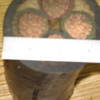Hello: I am drawing up a project: a freestanding cabinet with a rounded look to it mostly of white oak. The sides are going to be curved on the outside but flat facing in, starting with 8/4 material ending up about 5/4 by the time I remove enough material to make the curve. My question is this: I want to put a contrasting wood in the middle of the side, running top to bottom. I have the side in two pieces now that I have to glue up before contouring. I believe if I choose the wrong specie for the contrasting strip I’ll have expansion trouble. What wood would you recommend for this sandwich and should I use any joinery such as T&G or would just edge to edge glue up work. For the future how would I figure out which woods can be joined safely? I think we are talking about longitudinal expansion so finding two species with similar rates of expansion in the long dimension is the answer?
Thanks for considering my long question, KDM
Kenneth Duke Masters
The Bill of Rights December 15 1791 NRA Endowment Member
LEAA Life Member
CRPA Member
















Replies
What no takers? If my question isn't clear please let me know, I'll do my best to explain it.
Thanks, KDM
Hi Kenneth,
Sorry for the delay.
Most of the movement in this case is going to be in width, not thickness, so I'm not sure that this is even an issue. And the movement that does occure in thickness is going to be so minimal that I can't imagine it will affect the integrity of the joint.
That said, joinery can be used to your advantage here. If you join the center strip to the wide boards on either side with a tongue and grove, you will have a significant amount of gluing surface, and it will help keep the joint aligned. If you edge joint the boards, then biscuits or floating tenons will help similarly.
As far as looks go, ebony-esque woods go really well with white oak, hence its popularity in Arts and Crafts furniture. Rather than paying the high price for ebony you can use wenge (also nice because it shares a similar figure with white oak), or ebonized white oak, which will make your worries obsolete, because it's the same species. I put together this video on ebonizing white oak. It's really not that hard and turns out nicely.
I'm not big on using overly contrasting woods like bubinga or purpleheart. And if you use a wood that is too similar like butternut or even walnut, it might not be noticable enough.
Write back and let me know your thoughts on my comments.
Matt Berger
Fine Woodworking
Matt: Thanks for the reply, it was just what I wanted to hear and the delay was unimportant as I am working on another project (the small round table in the current issue of FWW). I have several dark woods in the rack and will pick one of them: Cocobolo, Morado and Black Walnut. Hopefully this will be the first project that I will feel comfortable posting on Knots. Thanks again, Duke
This forum post is now archived. Commenting has been disabled